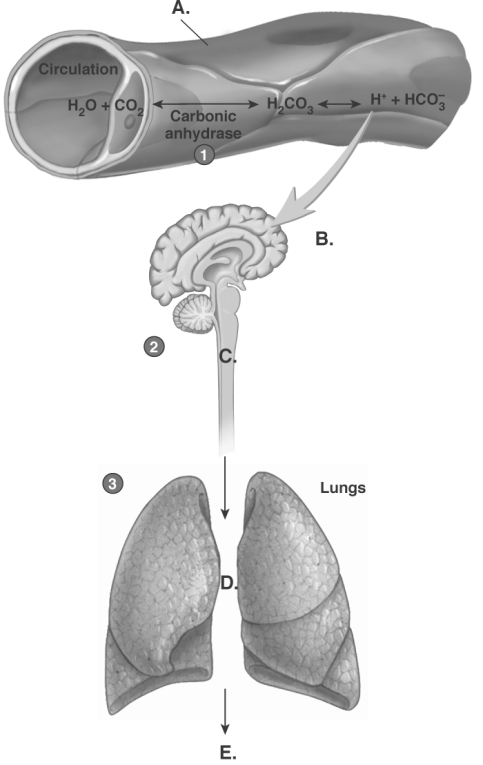A) vasoconstriction of blood vessels
B) increase ADH secretion
C) decrease aldosterone secretion
D) increase the release of atrial natriuretic hormone
E) increase aldosterone secretion
Correct Answer

verified
Correct Answer
verified
Multiple Choice
Indicate which acid-base imbalance is most likely to occur as a result of the condition described. -prolonged diarrhea resulting in excessive loss of bicarbonate
A) respiratory acidosis
B) respiratory alkalosis
C) metabolic acidosis
D) metabolic alkalosis
Correct Answer

verified
Correct Answer
verified
Multiple Choice
Decreased extracellular potassium levels cause
A) cells to become more excitable.
B) hyperpolarization of cell membranes.
C) more action potentials to be generated.
D) increased permeability of cell membranes.
E) hypopolarization of cell membranes.
Correct Answer

verified
Correct Answer
verified
Multiple Choice
A decrease in plasma osmolality would increase
A) ADH production.
B) plasma sodium levels.
C) renin production.
D) urine production.
E) thirst.
Correct Answer

verified
Correct Answer
verified
Multiple Choice
When aldosterone is absent, sodium reabsorption in the nephron is
A) greatly increased.
B) greatly decreased.
C) unchanged.
Correct Answer

verified
Correct Answer
verified
Multiple Choice
 -The diagram illustrates respiratory control of blood pH. What does "E" represent?
-The diagram illustrates respiratory control of blood pH. What does "E" represent?
A) respiratory control centers in brainstem
B) increased respiration and depth
C) increased CO2 from lungs
D) capillary
E) decreased pH
Correct Answer

verified
Correct Answer
verified
Multiple Choice
When normal buffer mechanisms are overwhelmed by excessive numbers of hydrogen ions, which of the following will result?
A) acidosis
B) alkalosis
C) neither of these
Correct Answer

verified
Correct Answer
verified
Multiple Choice
The increase in extracellular osmolality would cause
A) water to move out of the cells.
B) water to move into the cells.
C) no change in the net movement of water into or out of the cells.
Correct Answer

verified
Correct Answer
verified
Multiple Choice
The sensation of thirst results from
A) an increase in the plasma volume.
B) hypertension (increased blood pressure) .
C) stimulation of osmoreceptor cells in the hypothalamus.
D) a decrease in the osmolality of the extracellular fluid.
E) stimulation of baroreceptors.
Correct Answer

verified
Correct Answer
verified
Multiple Choice
Receptors sensitive to changes in the osmolality of extracellular fluid are the
A) baroreceptors.
B) chemoreceptors.
C) osmoreceptors.
D) pressoreceptors.
E) proprioreceptors.
Correct Answer

verified
Correct Answer
verified
Multiple Choice
An increase in parathyroid hormone levels results in
A) increased rate of bone resorption.
B) increased rate of vitamin D degradation.
C) increased concentration of potassium ions in the urine.
D) increased rate of calcium ion excretion by the kidneys.
E) decreased levels of blood calcium.
Correct Answer

verified
Correct Answer
verified
Multiple Choice
A falling blood pH and a rising concentration of carbon dioxide due to emphysema, indicate
A) metabolic acidosis.
B) metabolic alkalosis.
C) respiratory acidosis.
D) respiratory alkalosis.
E) None of these choices is correct.
Correct Answer

verified
Correct Answer
verified
Multiple Choice
Use the following key to choose the best answer. -(1) the percent adult weight that is water; (2) the percent of body weight that is water in a child
A) Choose this if the first item is greater than the second item.
B) Choose this if the first item is less than the second item.
C) Choose this if the first item is equal or nearly equal to the second item.
Correct Answer

verified
Correct Answer
verified
Showing 121 - 133 of 133
Related Exams